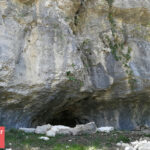UB team collaborates in the recovery of 74 war artefacts buried during the Spanish Civil War
The UB team carried out characterization studies of the subsoil with geophysical techniques which were key for determining the specific location of explosives buried in an area of an old airfield from the republican army during the Spanish Civil War. The study, led by the emeritus professor Albert Casas, expert on geological and geophysical prospection and mining research, included the participation of the lecturers Mahjoub Himi Benomar and Raúl Lovera, from the Department of Mineralogy, Petrology and Applied Sciences of the UB.


From an old military airfield to corn crops
The possible existence of those explosive was only known about for the story of a person who, before dying, explained s/he saw how several arms were buried in this republican army airfield during the civil war. Now, the land the old airfield covered are private corn crops, a territory on which the threat of the hidden presence of old armament loomed.
“The area of interest, according to the previous given information, was located on the border between the towns of Sant Privat del Bas and les Preses”, notes Albert Casas, former dean of the mentioned faculty. “Specifically, our technical study —he continues— consisted of a first characterization of the area where the prospection had to be conducted; the analysis of the historical background through the available old aerial photographs in the records of the Cartographic and Geological Institute of Catalonia; the planning and selection of the top techniques for the field work in the old airfield and the interpretation of the results”.
The experts ruled out the application of electromagnetic methods due to the presence of an overhead power line in the area of interest, an installation that could interfere in the signals of the magnetic and electromagnetic geophysical measurements in the area.
“Based on our previous experience in other forensic and environmental geophysical projects, and after consulting the available publications in the databases of electronic journals in the UB CRAI libraries —notes Casas– we decided to apply magnetic prospection techniques with a proton magnetometer adding profiles of electrical resistivity tomography”.
The magnetic method can capture the contrast of magnetic susceptibility among iron objects and sedimentary rocks that build the subsoil of the area of study. The electrical tomography (ERT) is regarded as the most efficient tool for characterizing the resistivity of the subsoil and determining the presence of underground metallic objects.
It was not only one projectile buried underground
The combination of both geophysical techniques allowed the researchers to define with a better precision the position, geometry, and the depth of the area —about two meters—, where the other unexploded ammunition could be buried. The magnitude of the magnetic anomaly they detected indicated it was not only one projectile but a series of artefacts that produced a magnetic anomaly altogether.
Finally, on 11 June, a team from the TEDAX-NRBQ Unit of the Mossos d’Esquadra from Girona successfully closed the recovery operation of the war material in the area indicated by the experts of the Faculty of Earth Sciences of the UB. As a result, they took 74 artefacts that will be safely destroyed in the Military Base of Sant Climent Sescebes (Alt Empordà).
Albert Casas was awarded the Bronze Medal to Police Merits with a blue badge in 2011, an award that honours the continuous and selfless collaboration of Casas and the researchers Mahjoub Himi, Raúl Lovera and Àlex Sendrós with the Group of Scientific Police of Mossos d’Esquadra in the section of forensic geophysics; specifically, in the detection of clandestine graves and burials through the techniques of subsoil radar and electrical tomography.
The details of the operation ara available on this video:
Press release from the Universitat de Barcelona


